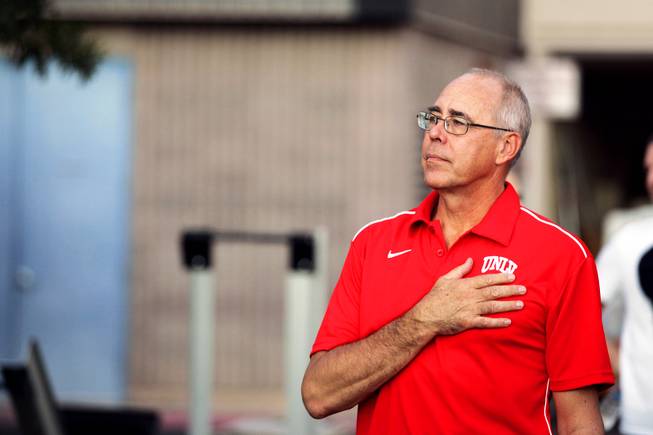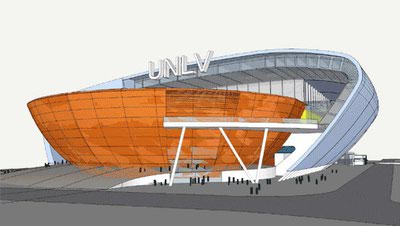
UNLV President Neal Smatresk listens the national anthem during the Premier UNLV event, an annual campus tradition that kicks off the fall semester in Las Vegas, Thursday, Sept. 1, 2011.
Sunday, July 8, 2012 | 2 a.m.
Reader poll
Related Content
- Regents approve on-campus stadium proposal for UNLV (12-1-2011)
- Negotiations extended for UNLV stadium project (12-1-2011)
- Developers: A UNLV stadium could be built without raising taxes (9-13-2011)
- Developers continue push for UNLV stadium, retail district (6-28-2011)
- Just build it already: Why Las Vegas can’t land a pro sports team (4-18-2011)
- Developers put early plans for UNLV stadium, retail district on display (2-1-2011)
- Regents to hear UNLV arena plan for football, basketball (1-31-2011)
- Mayor: UNLV domed stadium wouldn’t conflict with a downtown Las Vegas arena (1-27-2011)
- Report: UNLV domed stadium plans will be unveiled Tuesday (1-27-2011)
- Goodman: Arena project a key issue for next Las Vegas mayor (1-20-2011)
- UNLV acknowledges effort to bring stadium, football to campus (1-19-2011)
UNLV Arena Project
He built LA's Staple Center now Ed Roski has his sights set on UNLV for his newest arena project. What does it mean for Las Vegas? Watch and find out.
UNLV President Neal Smatresk is happy to point out that he’s a scientist by trade, not a stadium builder. This is new territory for him, something he’s had to learn on the fly as the UNLV Now project — a mega-events center including a stadium and retail district — moves forward with haste.
An on-campus football stadium has been the stuff of stories and jokes at UNLV for several years. But now — though this has been said before — it appears very likely that the Rebels will have a new home in the not-too-distant future, perhaps by the time today’s high school seniors graduate from college.
The project is a partnership between the university and Majestic Realty Co., which built the Staples Center in Los Angeles, among other projects. This is one of many sports-related construction proposals being discussed in the Las Vegas Valley, but this one has a different feel. This one seems imminent.
And it’s big. The Sun has reported the project could cost as much as $2 billion, but officials are hesitant to throw out any more numbers right now.
Smatresk has kept his wits about this behemoth idea by relating it to the world he knows best. Science is a series of checkpoints, a process with multiple pieces moving simultaneously but at different speeds, each one required to make the other work. Simplifying that requires focusing on finishing each one as it comes up and then moving on to the next.
Same thing with UNLV Now. It’s enormous, both in scope and potential physical size, so focus by ticking each checkmark off the list, chopping down the tree one controlled swing at a time.
That’s what Smatresk and the UNLV Now team — UNLV officials, Majestic reps and outside consultants — have been doing, and it has them in position to dramatically change the UNLV campus and the broader community.
Is this project what the city and university really need? Can it survive when many other stadium and arena proposals in this city have failed?
“My belief may not be strong enough,” Smatresk said, “but I’m pretty sure I’m not wrong.”
Smatresk spoke at length about the project in a recent interview, which has been edited for clarity.
On the goal of the project ...
UNLV wants to be the state university in this state. We want to be the place you think of. We want to be a first-choice institution. That’s our aspiration. ... Sports are the front porch for the university. Come on up to the front porch, and we hope you walk in the door and get more involved. Lots of our foundation donors and people on our foundation board — and it’s a list of the who’s who in Nevada — many times they came into the university through our athletics programs. We know athletics are a draw, and we want people to be engaged in the whole university, not just in the athletics portion. But by building that attractive front porch and having people involved, we know we’ll get more of that engagement.
On benefits of the project for UNLV ...
Three ways you can see benefits: gifts given directly into endowing accounts, direct financial benefits of a good business plan that lessens the state’s obligation to fund the athletics program and puts that money back into academics, and indirect benefits to student and student-athlete recruiting. I think that’s all good.
On the benefits for other entities ...
Every year we pass on really big events that could bring a ton of money into town because we don’t have a covered venue that seats 50,000-60,000 people. We’re the biggest convention city in the world, yet we have to pass on things like the Republican and Democratic national conventions or exhibition football games. This location benefits the Strip, the campus and the university.
On the additional money this project would bring to town ...
Our economy has a hole in it from a conventioneering and export economy perspective. Madonna’s world tour can come here, but it can’t seat more than 18,000 people. How much more money do you make, not just on the event, but in town when you put 50,000 or 60,000 people in seats? A rough cut of the economic analysis suggests that with between 15 and 20 mega-events a year — because UNLV football isn’t going to drive a large economy for our city, yet — we could generate in raw export dollars, not economic impact but sheer dollars, about $500 million of new money, money not replicated from any current activity or any arena. That’s a big number. The tax that it generates is enormous.
On how the arena proposal would affect academics ...
We’re not taking state funds to do this. We’re not taking tuition to do this. That money is inviolable. That money goes to our educational programs, period. ... Your first pledge has to be you’ll never hurt academics when you do this, you won’t hurt your efforts to support the state or to get people degrees and give them a great education. Knowing that, then the question is, “Could that money have been used for academics?” And the answer is, “Not really.” People who are going to give to this are going to give both out of a sense of pride in community and a sense of what I would call enlightened self-interest or venture philanthropy. ... Is that money going to come here in giant chunks just to support the university? I don’t know. I’d love to think it would, but I kind of think this project is the thing that brings it, and I think most people would agree with that.
On the timeline ...
In my dream world, I’d like to say that for the next year and a half, we get the financing all tied up and the plans all tied up and we know exactly what we’re going to do. And then hopefully we’re ready to go. It could be faster if we got really great support. I mean it could be in five years this puppy was getting ready for a grand opening. That’s an optimistic timeline, but it could happen.
On support for the project ...
If you walk around our campus, there might be a few faculty and staff members who are concerned about this in a negative way. The vast majority are excited, so excited they can hardly stand it. They’ve wanted this for years. Our alumni are going nuts over this. We’ve got a lot of alum legislators, and they’re saying, “How can we help?” There’s a grass-roots enthusiasm for this project that I believe has a sense of correctness for this region and for the community. To me, it’s like pent-up goodwill.
On how this project affects the chances of an NBA team coming ...
It’s not really a part of the plan. ... I’d probably be as excited as anyone in this state to see the NBA come here. Do I worry about this and what impacts it might have on Thomas & Mack and its revenue flow? Yes, I do. And I’d be silly not to. Having said that, from a regional perspective, I think it’d be good for us.
On what he’d like to see in five to 10 years ...
I want to see this facility be nationally recognized as one of the best in class. I would like to see it be filled with a lot of great events. I would like to see it create excitement and buzz about the university. I’d like to see the number of beds on campus go up to 6,000 or 7,000, which we think is fairly reasonable. We would like to see that it drew in national media attention to the Rebels, whether it was football or basketball, and that it made us a very attractive university for people.
Final thoughts ...
Will we get this done? I don’t know; I hope so. I feel like the team is in place. Really, the question is: Does the city, region and county think this is a valuable proposition? Or will donors and founding partners find value in this because it will help them improve their economies? If it does and they do, then I think we’re going to be in good shape. But we definitely need our friends in the business community here, and everybody in Las Vegas, to be really supportive of this. ... If I’m guilty of something here and the university is, it’s having big dreams. I say it’s time to have big dreams for the city. It’s time to get our pride back. It’s time to be brave and to go out and do it. Be done with being afraid; it’s time to be bold.
Taylor Bern can be reached at 948-7844 or [email protected]. Follow Taylor on Twitter at twitter.com/taylorbern.


Join the Discussion:
Check this out for a full explanation of our conversion to the LiveFyre commenting system and instructions on how to sign up for an account.
Full comments policy